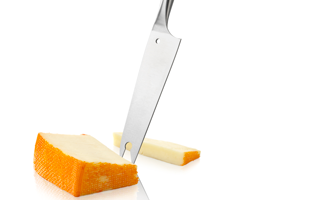Grate Tips: Guide to Serving Cheese!
Say ‘Cheese’!
The Americans serve cheese as a starter, the French before dessert and the English as the grand finale of a meal. Such indulgence is usually enjoyed during fine dining or parties where you want a centrepiece for your guests to enjoy. If you have not had cheese for your gatherings, you don’t know what you are missing!
1) Serving size
A general rule is to serve 100 to 120 grams per person. As a light appetizer, an exquisite cheese is sufficient. For a main party dish, the recommended minimum would be three types or a maximum of six. Try not to overwhelm your guests’ taste buds as cheeses have complex flavours. Always serve the cheese at room temperature when it is at its natural texture. Keep it unrefrigerated for at least an hour before serving.
2) What kind of cheese should be presented on my cheese platter?
For a basic variety, we usually go for a soft cheese, a firm cheese and a blue vein cheese so guests can enjoy the different textures. The visual presentation will also be more distinct with the different colours and shape of the cheeses.
Here is a list of cheese selection by their textures.
| Types of cheese | Common ones found |
| Soft | Cottage or farmer’s cheese, young goat’s cheese, Brie, Camembert |
| Semi-soft | Bel Paese, Stilton, Pecorino Toscano or Havarti |
| Semi-firm | Asiago, Roquefort, Fontina, Edam, Gouda or Mahon |
| Hard | Cheddar, Colby, Blue Cheshire or Tête de Moine |
| Extra hard | Parmigiano Reggiano and Mimoulette |
Choose a theme for your cheese platter, such as French, Swiss or American and select your cheeses and decorate accordingly.
3) Which wine pairings are appropriate?
One or two different wines are recommended. Fresh cheeses pair well with Sauvignon Blanc or Pinot Noir, blue cheeses with Sauternes and Port, and aged cheeses with Zinfandel or Burgundy. When in doubt, choosing a wine from the same location as your cheese will not go wrong.
4) Decorations
It is scientifically proven that humans enjoy their food better when they look delicious! Turn your cheese board into edible art by garnishing it with sides such as figs, grapes, apples, tomatoes, celery and dried berries to add colour and flavour. Accompaniments like bread and crackers can also be part of the decorations. Make sure your bread and crackers are not too salty or strong which can compromise the taste of the cheese.
5) Specialized tools?
Get the full cheese experience with specialised serving tools!
A cheese board should be the first item you look at. Choose from a wide array of materials; with those made of wood being the most common. Alternatives include marble slabs, ceramic and glass cake platters, shallow bowls or plates.
Cheese knives are a must. A long knife with the forked tip is good for cutting softer cheese and doubles as a spreader. At times, you’ll see it with holes down the blade which helps keep the cheese from sticking to the blade. It can be used to chip away at harder cheeses and spear individual portions of cheese. The spade-shaped knife has a sharp edge for cutting hard cheese into slices. The pointed fork is good for chipping away at harder, aged cheeses like Cheddar and blue cheeses like Stilton, and transferring cheese from the board to individual plates. The flat knife that looks like a shovel is good for cutting cheese into cubes or slices, or as a spatula to transfer the cheese to a plate. The small rounded knife is a spreader for soft cheeses. Always use a different knife for each type of cheese so that the flavours do not mix.

